Do you ever imagine the Bulldog as an admirable athlete? Though the breed name is most often associated with the English Bulldog, its American counterpart is very different in both appearance and temperament.
Owning one is a privilege, but the blue coat color adds a little bit of extra spice by manipulating the genetics of the breed. Not many dog breeds can wear this steely color as impressively as the American Bulldog.
If you want to expand your canine family or simply add a dog to your home, the blue American Bulldog might tickle your fancy. I will give the whole picture, including the process behind a magnificent coat color, general appearance, temperament, health, and lifespan.
What Makes The Blue American Bulldog Special?
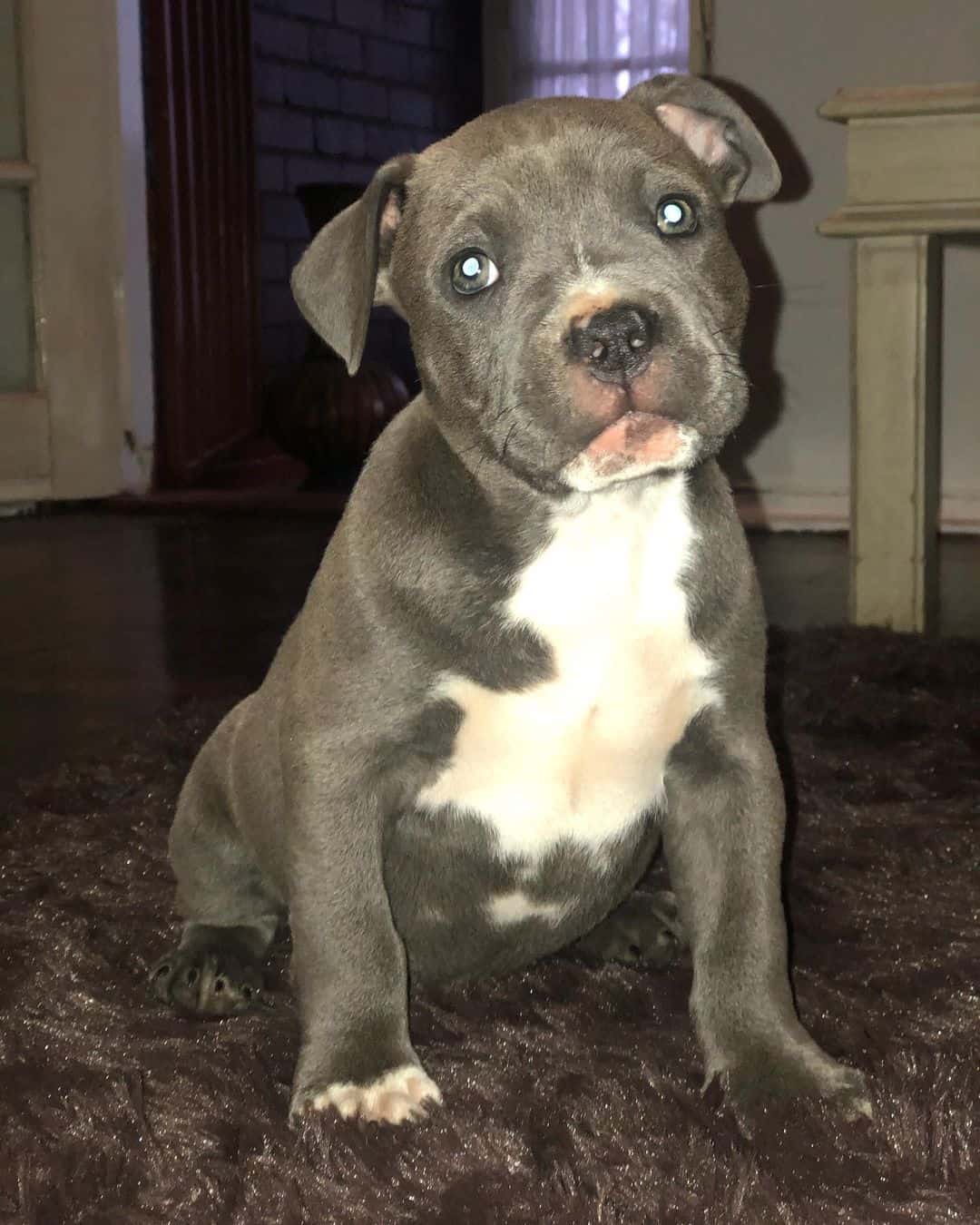
Descended from the original English Bulldog, the American Bulldog is commonly referred to as the Johnson American Bulldog, White English Bulldog, or Old English Bulldog.
Because this breed was almost wiped out after the Second World War, John D. Johnson scoured the southern parts of the US to find pure bloodlines with the aim of preserving the breed.
Thankfully, his mission was accomplished, and today we have many American Bulldogs to choose from. Centuries ago, the breed was actually used to bait bulls, but in the Southern US, it had the role of hunting feral boars and protecting farms.
Its physique was perfect for this job, but the only color available was white. In the modern day and age, breeders started introducing American Bulldogs with a recessive gene on the D locus into the gene pool, ultimately creating the blue-colored American Bulldog.
This canine genetic manipulation opened the door to new colors without affecting the athletic, muscular build and protective yet affectionate temperament of the purebred dog. Hence, our first stop will be to explain how dilution genetics work and why it is called blue despite being gray.
A Recessive Gene Dilutes The Blue American Bulldog’s Black Coat
Alleles, or variants of a gene, reside in specific locations on the pigment gene. That location is called a locus, and depending on the pair of alleles found on a locus, an American Bulldog can have different coat colors or patterns.
Eumelanin is the pigment responsible for the dominant black color in dogs, while phaeomelanin contributes to the red color. Since the American Bulldog bloodlines were gradually bred to produce more than just white, black made its way into the breed.
Although the K locus has the dominant gene producing black, in American Bulldogs, the A locus (agouti) is responsible for a black coat. However, this type of black is called recessive black because the A locus controls the mixing of eumelanin and phaeomelanin to create patterns.
If one American Bulldog parent has a recessive allele (a) and the other does not, the litter will carry the gene but not display its color. Both parents must have the recessive gene on the A locus for the dog to express a recessive black coat color.
Now that we know how American Bulldogs get their black coloring, we need to visit the D locus to understand the dilution into a lighter shade of color.
If one parent has the recessive gene (d) on the D Locus, the American Bulldog puppies will only carry the gene but not express the color. A pair of recessive genes in a puppy inherited from both parents will dilute the color determined by the recessive black from the A locus.
This coat color is not actually blue but light to medium gray. Calling it blue is simply a way to attract more attention, and by now, you probably know a blue dog is actually not blue.
The Nose And Eye Color Are Different Too
Phaeomelanin, unlike eumelanin, does not affect the color of the nose or eyes. Since the A locus (agouti) controls the production of both pigments, a blue American Bulldog’s eyes and nose will have a diluted color too.
In the majority of cases, the normally black color of the nose and dark brown eyes will be affected by the recessive gene on the D locus. So, when you hear or read about a blue nose American Bulldog, it is simply a dog with a diluted main color.
Blue eye color can be affected by more than the merle (M locus) and piebald (S locus). A study conducted by Embarkvet showed that a duplicated DNA sequence near the ALX4 gene, completely unrelated to the loci usually associated with the mutation, can cause blue eyes.
Still, it is a sensible conclusion because the ALX4 gene controls the development of follicles of the skin, face, and hair, so eye color in dogs is likely to be influenced too.
This theory is viable for dogs that do not display dilute gene properties, and the blue eyes in a blue American Bulldog are probably a result of the recessive gene (d) on the D locus.
Same Physique, Different Coat
Excluding the coat, eye, and nose color, the anatomy of the blue American Bulldog remains identical to the standard color version. Males grow up to between twenty-two and twenty-seven inches tall, with females being slightly smaller at twenty to twenty-five inches.
A large-sized muscular build means that it is a rather heavy dog breed. Males weigh between seventy-five and one hundred twenty-five pounds, with females reaching sixty to one hundred pounds.
One thing that makes the American Bulldog unique is its mesocephalic muzzle. It is of short length but not as short as brachycephalic breeds such as a French Bulldog. The United Kennel Club recognizes two types of American Bulldogs based on the features inherited from different breeds.
A Johnson Bulldog will have a muzzle closer to brachycephalic with a square skull, while a Scott type’s muzzle is mesocephalic with a wedge-shaped skull. Another feature of the Scott type is a more lean body with thinner bones and a less stocky build.
Both versions have triangular hanging ears that become level with the head when the dog is alert. A slightly pronounced brow bone matches the very steep stop that has skin folds around the connection with the muzzle.
A thick neck connects the head with well-developed shoulders that frame a broad chest. Front and rear legs are muscular, but not overly, and the back is straight up until the sacral portion, which is minimally slanted.
The tail is long and narrows into a point but serves as an extension of the back that prolongs the silhouette of the body frame. Keep in mind that this appearance is breed standard.
Coat And Grooming Needs
An American Bulldog’s coat is short, smooth, and very snuggly set against the skin. The roughness of the hair can vary from one dog to another, but in most cases, it is soft to the touch.
The breed does not shed a lot. American Bulldogs are by no means allergy-friendly, but they will not cause major problems either. Grooming them will be fairly easy, so two hours per week should be enough to maintain coat smoothness.
Colors are usually white with black spots, brindle, or buckskin. Essentially any color mix is acceptable, but the UKC does not recognize solid black, merle, or tricolor as a breed standard.
Nail trimming can be done occasionally to avoid accidental scratches on the floor or furniture or to avoid injury while running. Large breeds can be clumsy at times, so a torn nail is among the most common injuries.
What About Temperament?
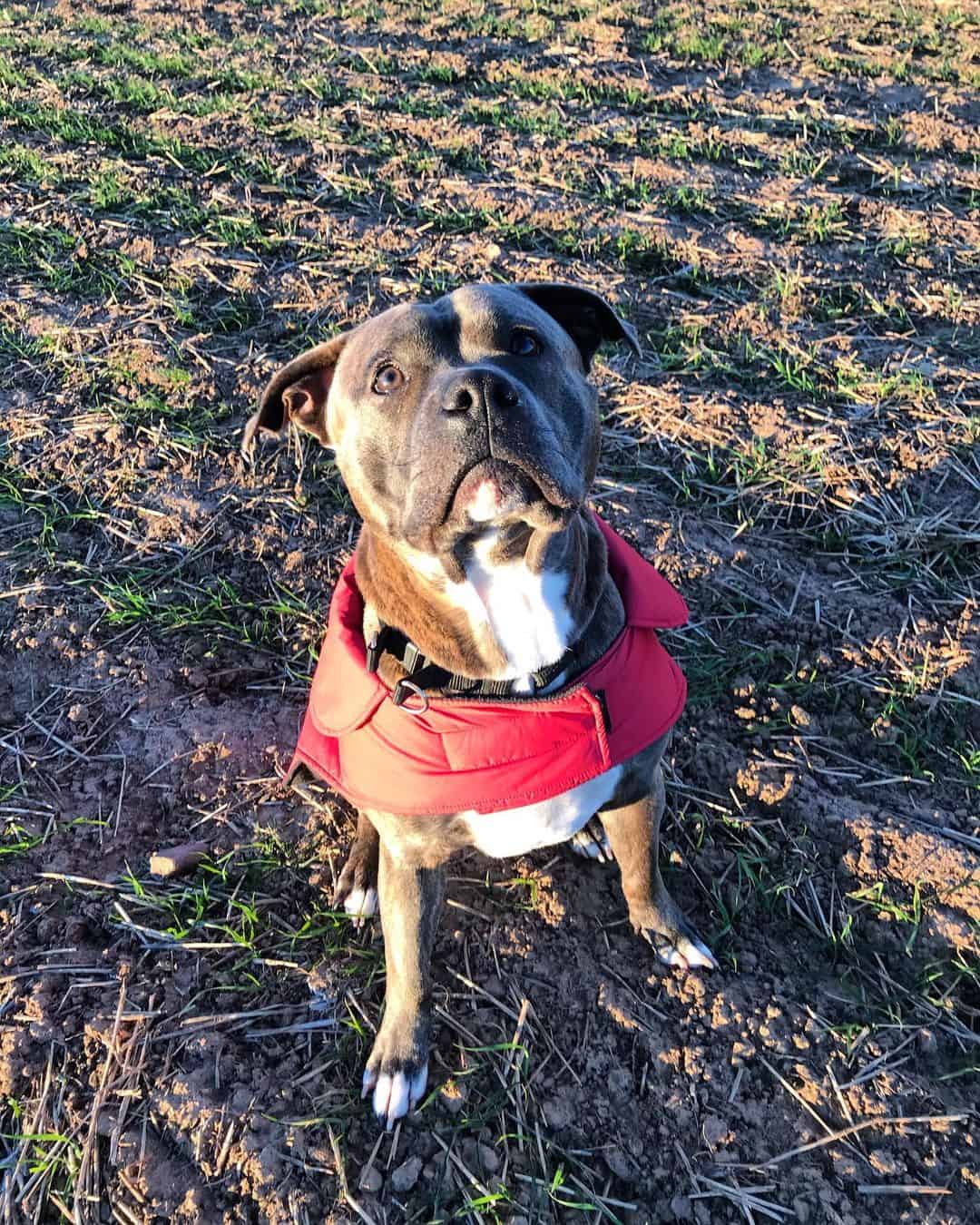
Bulldog breeds are known for their stubbornness, but the American Bulldog is quite trainable for the role it was initially bred for. No, they will not be as easily trained as Collies, but their protective instinct made them natural guard dogs.
Performing their guard duties without any special training means they know what they are doing. Other than watchdog duty, they were used for hunting too, which makes them excellent utility dogs.
You would think that being a large breed, they would not be affectionate, but that is plain wrong. Resting inside the house will show a whole new level of lapdog potential in your American Bulldog.
First-time owners should avoid getting an American Bulldog. Its domineering and strong presence will require an owner who knows how to lead and train obedience with positive reinforcement.
Pet parents considering an American Bulldog should mind their living conditions. A house with a large yard is preferable to an apartment. Large dogs with high-energy levels require space to play, so mind your china.
Socialization
Although this is a working dog breed, they are amazing with young children but wary of strangers. Guests will be well-inspected before coming into the house, so make sure you expose them to other people as puppies if you wish to avoid trouble later on.
Living with other smaller animals like cats, bunnies, or hamsters will be doable as long as they know co-habitation is a must from an early age.
If you have other dogs living in your home, early socialization is key to preventing fights and other aggressive behavior. This is especially important if you own large dog breeds such as Rottweilers, Mastiffs, Cane Corsos, etc.
As pack animals, they do not do well if left alone for long periods of time. Dog owners should make sure that daily exercise is maximized with plenty of mental stimulation given through obedience training and puzzle toys.
Even if separation anxiety is a more common behavioral issue with small dog breeds, the American Bulldog can miss its owner so much that the furniture suffers the consequences.
Blue American Bulldog Diet, Health Problems, And Life Expectancy
The American Bulldog breed is predisposed to certain genetic diseases that plague most large dog breeds. Among them are eye problems, heart conditions, dysplasia, thyroid issues, and cancer.
A big problem majorly influenced by owners’ lifestyles is obesity. Being one of the most common health problems in American Bulldogs, obesity paves the way for other conditions, making it more susceptible to secondary conditions like diabetes, high blood pressure, digestion complications, etc.
We should start off with the one you, as a dog owner, can do something about — obesity. We will talk about what kind of diet and food habits you should instill in your dog’s everyday life along the way, so make sure you remember well.
Nutrient Ratios And Supplements
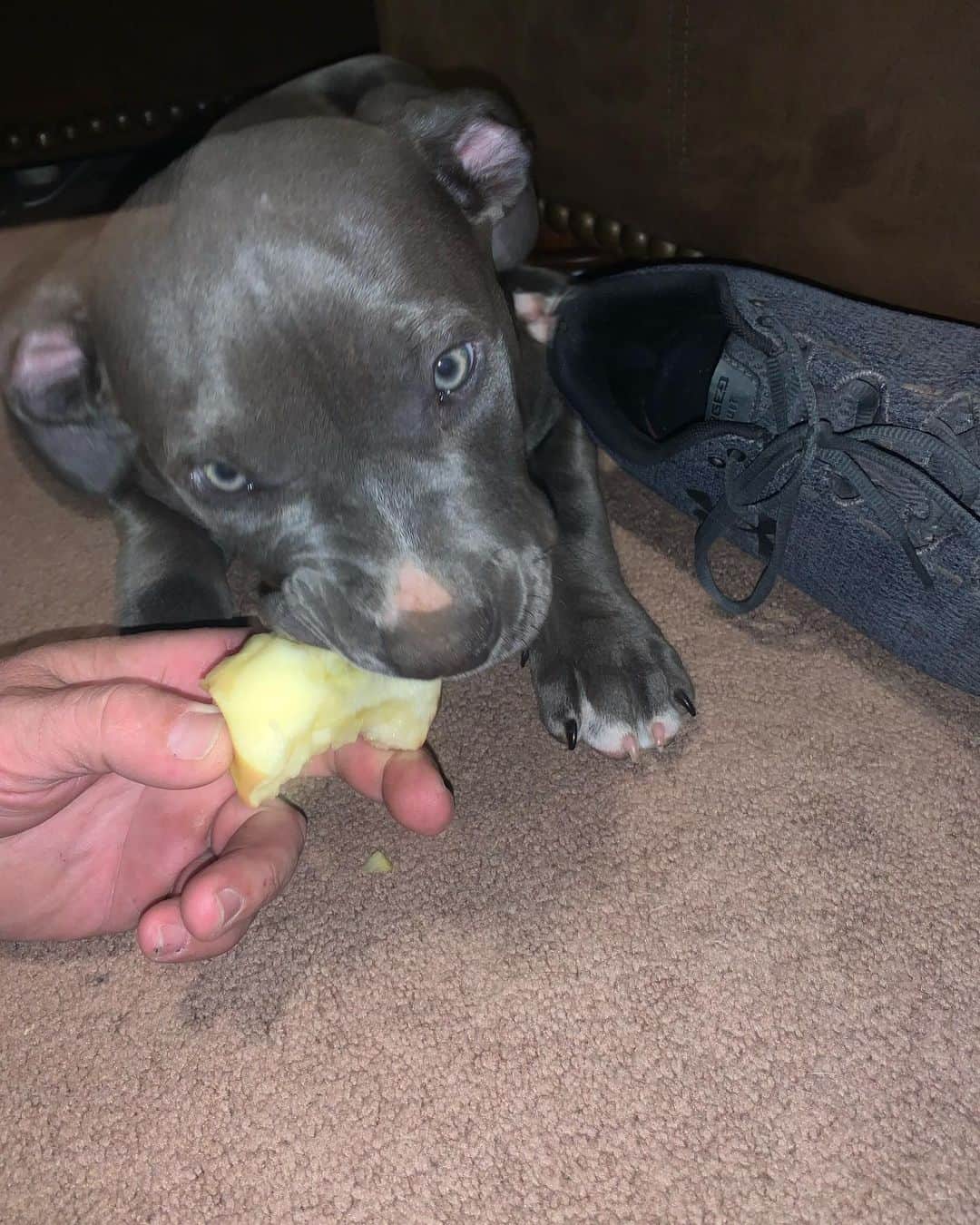
Calorie intake is, ironically, the most overlooked aspect of dog health. American Bulldogs are hefty creatures that require quite a bit of food to grow into healthy adults. Feeding them a lot of food is not the right way, as certain nutrients are overly present in commercial foods.
Big, muscular dogs should have high-protein, low-fat diets with low to moderate amounts of carbohydrates. The ratio should always be around twenty percent protein, three to five percent fatty acids, and fifteen to twenty percent carbs.
American Bulldog puppies should have slightly more protein in their diet, with a figure of around twenty-two to twenty-five percent dry matter. Feeding them animal fat is not recommended, as it does not have any particular benefits other than increasing the chance of obesity.
The best source of fatty acids such as omega-3, six, and nine are fish oil for omega-3 and nuts and seeds for omega-6 and nine.
Carbohydrates should be given in moderation, as puppy bodies still do not have a fully developed stomach with the required enzymes to break them down. Complex carbs like grains should not be part of puppy or adult dogs’ diets.
Do not forget vitamins and minerals such as calcium, phosphorus, folates, etc. Commercial dog foods and raw or home-cooked diets often do not have enough of these, so supplements are recommended. Consult your vet before buying any dietary supplements for your dog.
Feeding Habits
We have a great feeding chart for American Bulldogs you can use to monitor your dog’s calorie intake and reference the weight with the table sorted by weeks of age.
In the same article, we talk about types of diets (home-cooked, raw diet, kibble, etc.) and which one is best for an American Bulldog.
Food management and treats in moderation are only half of the equation of avoiding an overweight or obese dog. Physical exercise is not an option for this breed. Make sure you provide plenty of activity, and not immediately before or after meals.
To avoid bloat and GDV, make sure to feed your dog at least two meals a day to avoid massive portions being eaten in a single sitting.
Allergies
Seeing as both the Johnson and Scott type American Bulldog have shorter muzzles than other breeds of dog, the anatomy of the brachycephalic or mesocephalic muzzle can be a problematic physical trait when it comes to inhalant allergens.
Every household has dust, dust mites, and mold, which means your dog sniffing around hard-to-reach corners can get those allergens inside its airways. Over time, constant exposure to these harmful particles will make the immune system respond more aggressively to them.
An allergic reaction to any of those will start displaying symptoms like itchy skin, sneezing, pawing, restlessness, or even more serious signs of allergies. Seasonal allergens, such as pollen, particles from air pollution, etc., have the same effect.
While most, if not all, of these allergens, showcase symptoms on the skin, food allergies mostly affect the digestive tract. It is not uncommon for dogs to exhibit an intolerance or allergy to proteins in food. Even simple carbs can cause this reaction.
Never use home treatments on dogs with food or other allergies without consulting a vet and doing some allergy tests for dogs. Food allergy symptoms include vomiting, diarrhea, loss of appetite, as well as skin itchiness, redness, skin surface changes, etc.
Eye Problems
For certain large dog breeds like the American Bulldog, Rottweiler, Mastiff, etc., cherry eye is a common eye problem. Due to a genetic mutation of unknown origin, their third eyelid gland extrudes from its natural position.
While this is not a serious condition and can be fixed with routine surgery, it is important to know the symptoms. It includes red eyes, a cherry-looking mass in the corner of the eye(s), burst capillaries on the cornea, etc.
For more causes of red eye in dogs, check our very comprehensive article on the majority of conditions that can induce eye redness in your dog.
Lens luxation is another condition that is not that common but is still a possibility in American Bulldogs. It is described as a detachment of the lens from the frontal or anterior eye structure, causing eye fluids to become trapped behind the lens and increase intraocular pressure.
Treatment is a moderately complex surgery that can have varying results, but a procedure called phacoemulsification has a high rate of successful recovery without complications.
Another inherited disease that American Bulldog puppy parents get tested for is Canine Multifocal Retinopathy 2 (CMR2). The detachment of the retina is seen on several circular spots in the eye.
Symptoms are quite specific and include formations similar to colored blisters that appear due to the fluid becoming trapped behind the retina. Although vision loss is not a given, it has been the case in some dogs.
Degenerative Myelopathy
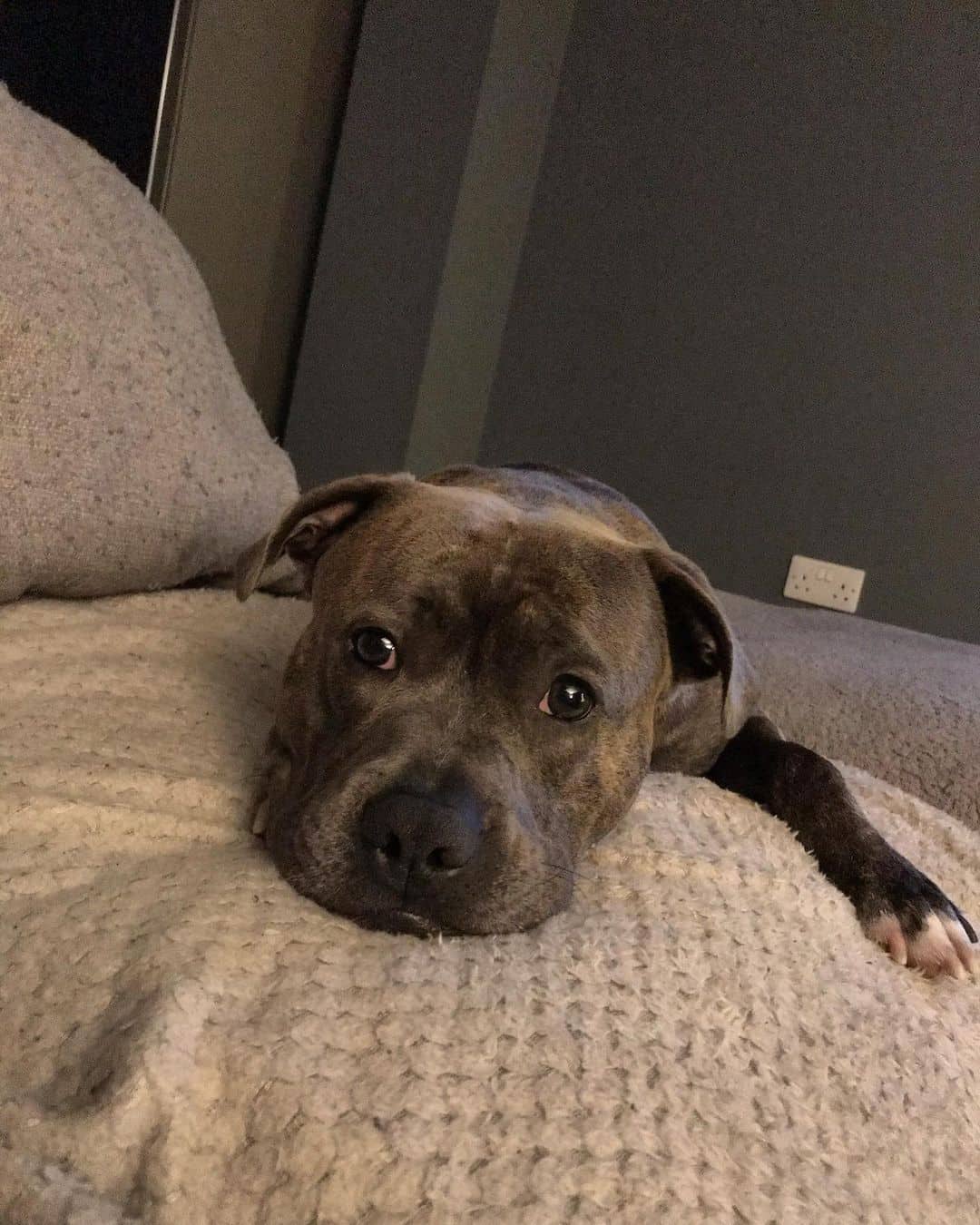
With dogs that have genetic mutations, like the blue American Bulldog, other abnormalities can have a higher chance of happening. One of those mutations happens on the superoxide dismutase 1 (SOD1) gene.
The disease is neurodegenerative, which means it affects the nerves. Because it develops as a dog ages (approximately eight or nine years of age), early symptoms are usually ataxia (loss of coordination) and involuntary muscle contractions in the rear legs.
Ultimately, complete paralysis of the rear legs, accompanied by uncontrolled urination and defecation, spreads to all limbs. Usually, with the onset of complete paralysis, your vet will recommend euthanasia due to a basically non-existent quality of life.
Neuronal Ceroid Lipofuscinosis
This condition is not a single disease but a group of progressive neurological central nervous system conditions that usually end with death. Since it is hereditary, there is no cure or treatment for it.
Dogs, in their first couple of years, start exhibiting symptoms such as aggressive behavior, constant circling, lethargy, and in later stages of the disease, ataxia, seizures, and progressive blindness.
Lack of treatment means only secondary care is an option, but dogs with severe clinical signs are most often euthanized by the time they are three years old. This makes for a prognosis of twelve to twenty-four months of life after the onset of the first symptoms.
Hypothyroidism
Bulkier dogs are genetically predisposed to this condition. With reduced production of thyroxine and triiodothyronine, metabolism, nutrient absorption, body temperature control, and similar key functions are inhibited.
The most common causes are inflammation, or the thyroid shrinking due to an autoimmune disorder that mistakes the gland for a foreign body and attacks it to remove the wrongly perceived threat.
Symptoms include worsening of coat quality, hair loss, apathy, loss of appetite, or even weight gain without eating more. Treatment consists of hormone replacement therapy by administering synthetic compounds like levothyroxine.
Elbow And Hip Dysplasia
Dysplasia is a congenital disease in the majority of cases. During the formative years of a blue American Bulldog puppy’s life, the ball of the elbow or hip does not fully mature.
With that anatomical defect, the fit that the ball should have with the socket of the joint is not perfect, in a way that pressure while moving is not evenly distributed throughout the entire structure.
The cartilage that provides cushion and prevents the two bones from grinding against each other wears off over time, allowing for direct contact between the ball and socket. The damage caused in this process ultimately leads to arthritis, which causes pain and difficulty moving.
Milder cases that are diagnosed early can be treated with NSAIDs, but more severe manifestations require either osteotomy or hip replacement surgery. Most dogs that undergo surgical treatment have a good quality of life afterward.
Ichthyosis
Now we are in the rarest case scenario. This skin condition is not common, but American Bulldogs, especially those bred with recessive genes, such as the blue American Bulldog, can have a higher chance of developing it.
In essence, ichthyosis causes the outermost layer of the skin (epidermis) not to develop properly. Its name was inspired by the greek word for fish scales due to the scaly quality of the skin on affected dogs.
The diagnostic method used is a skin biopsy. If a positive diagnosis is established, the treatment mostly includes secondary care, like regular use of medical shampoos, ointments, and dietary changes.
Considering the rarity of the condition, the prognosis is not great. A substantial number of dogs suffering from ichthyosis are euthanized due to the symptoms worsening without a successful long-term treatment option.
Life Expectancy Of Blue American Bulldogs
All in all, the breed is healthy for a large dog. With a good choice of breeder, proper diet, and regular vet checkups, you are looking at a lifespan of ten to fifteen years.
Perhaps the biggest part of seeing your blue American Bulldog live close to the upper age limit is breeder choice. Nowadays, there are DNA tests performed on adult dogs that can detect the predisposition of their puppies to inherited conditions.
Most commonly performed DNA tests and scans among breeders of American Bulldogs include hip dysplasia OFA-certified scans, CMR1, DM, ICT-NIPAL4, and NCL10 genetic tests to rule out hereditary genetic diseases.
Regular exercise and a diet that has plenty of nutrients necessary for maintaining muscle, bone, and skin health on a high level will help your American Bulldog celebrate its fifteenth birthday.
American Bulldog F.A.Q
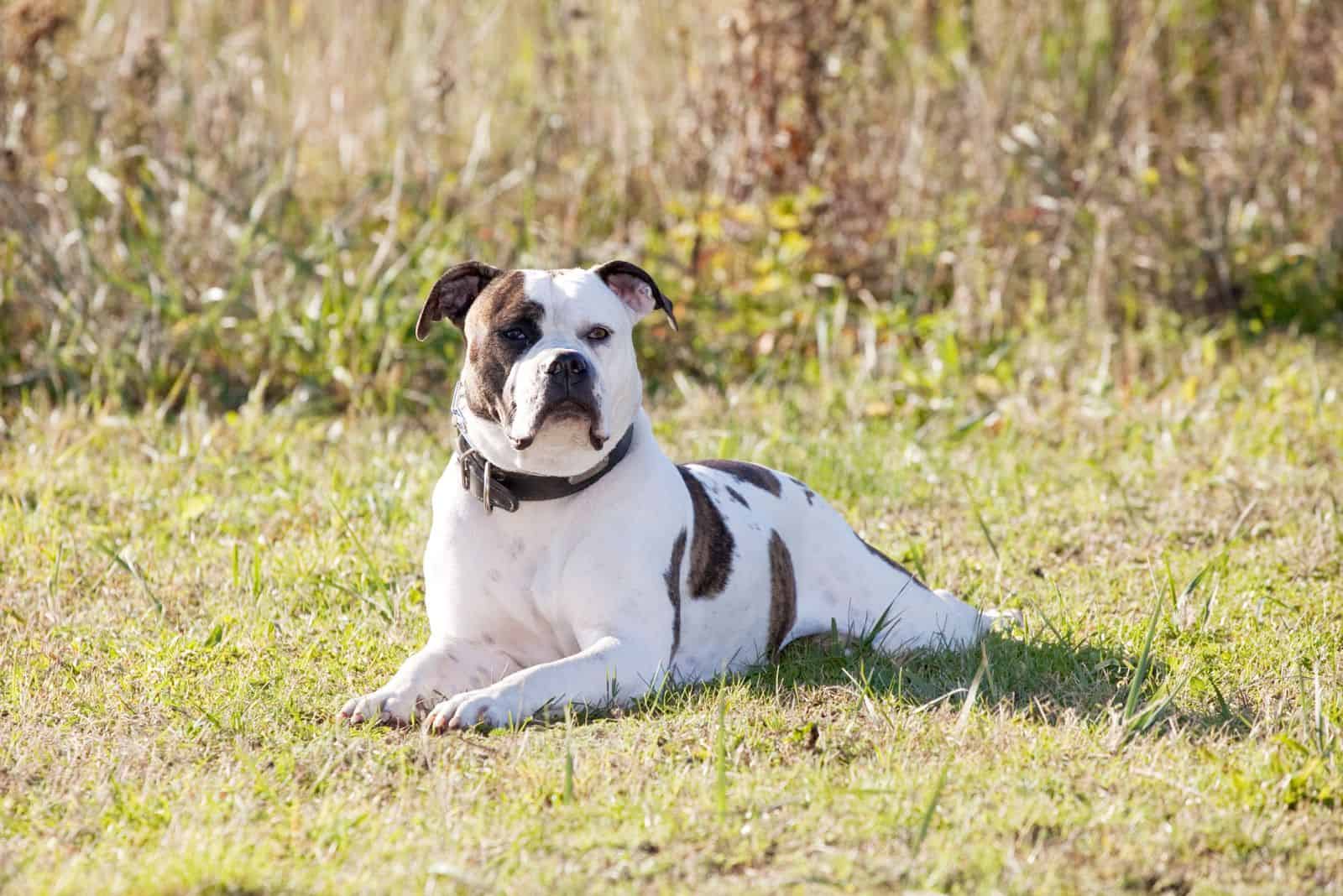
What Are The Different Colors Of The American Bulldog?
We can always speak about standard and non-standard coat colors in dogs. American Bulldogs usually have a main white coat with black, brindle, brown, or tan spots. These all fall under the breed standard category.
Less common and achieved by selective breeding of American Bulldogs with recessive genes are lilac, blue, chocolate, black, and merle. The American Kennel Club, United Kennel Club, and Continental Kennel Club do not recognize these as standard.
The American Bulldog Association opposes the standards that are imposed by the AKC, for example, as they believe the already established physical and temperamental standards are crucial for breed preservation.
However, they share the same viewpoint when it comes to coat colors. This means that a lilac, blue, chocolate, black, merle, or blue American Bulldog will not be eligible to participate in conformation shows.
What Are The Two Types Of American Bulldogs?
We already mentioned the two types in the physical appearance part of the article. Johnson-type and Scott-type American Bulldogs are the two types that are differentiated by some facial and body features.
A Johnson-type American Bulldog will be more muscular and square-built, while the Scott type is also known as the “performance” American Bulldog due to its more athletic build.
The Johnson-type has a shorter muzzle than the Scott, having a face more similar to that of an English Bulldog. Scott-type American Bulldogs are often mistaken for Pit Bull Terriers or American Staffordshire Terriers due to their more compact frame.
In terms of temperament, both dogs are the same loving canine family members we met in the temperament section of the text.
Can You Get A Blue American Bulldog?
Theoretically, yes, you can. It will be difficult to find one in practice, though. Since they do not conform to American Bulldog breed standards, the vast majority of reputable breeders do not breed American Bulldogs with recessive genes.
Another disputed topic that makes the blue American Bulldog rare is the fact that recessive genes affecting coat, nose, and eye color can increase the risk of other genetic mutations. That means a dog with a merle or blue coat will be at greater risk of genetic diseases.
In many cases, the breeders who claim to sell purebred blue American Bulldogs do not do genetic testing on the puppy’s parents because they are aware of the health risks involved. For this reason, finding a reputable breeder with blue American Bulldogs is nearly impossible.
How Much Is A Blue American Bulldog Worth?
Many factors, including exclusivity, litters per year, breeding programs, etc., influence the cost of a blue American Bulldog. In the best-case scenario, you will have to spend around $2000 to $5000 dollars in acquisition costs.
Keep in mind that backyard breeders and puppy mills will often offer “discounted” prices for alleged blue American Bulldogs, which should be avoided at all costs.
Only consider buying from breeders who have health and pedigree records and offer full transparency of their breeding program.
Conclusion
I believe we have exhausted everything there is to know about the blue American Bulldog and even about the American Bulldog in general. The decision to get one is a tough one due to the potential problems you might encounter along the way.
Regardless of color or potential health risks with the blue American Bulldog, if you need a family dog that will serve as a stalwart protector of the home and its inhabitants, this is the one for you.
Considering it is a large dog breed, it has a pretty long lifespan, which means you will have plenty of time to bond with your new canine companion, and it will most likely grow up alongside your children.
Balancing the health risks and breeder choice with its amazing physical and temperamental traits is no easy task, so take your time before pulling the trigger. In any case, I hope you will now have an easier time reaching your decision.















